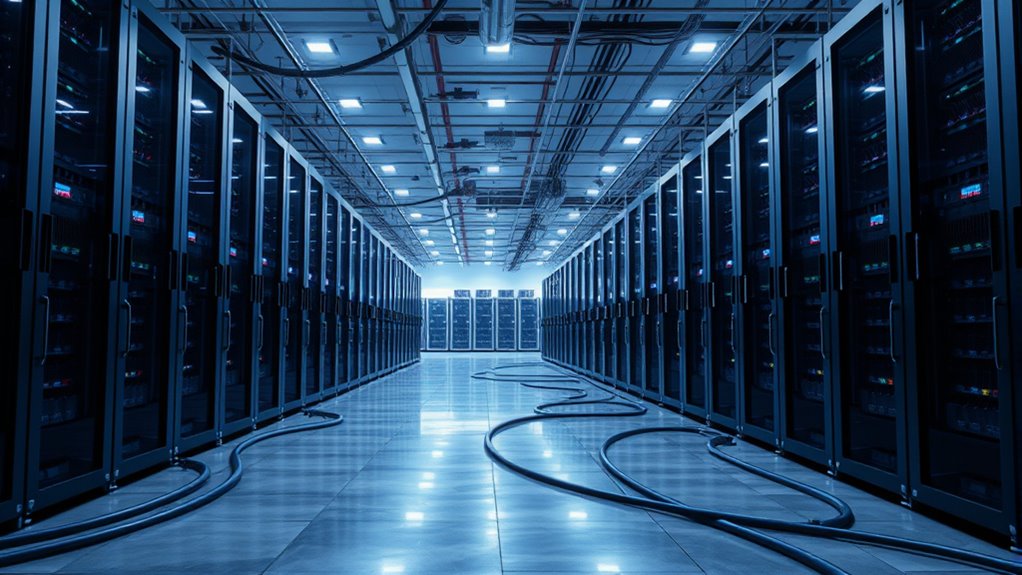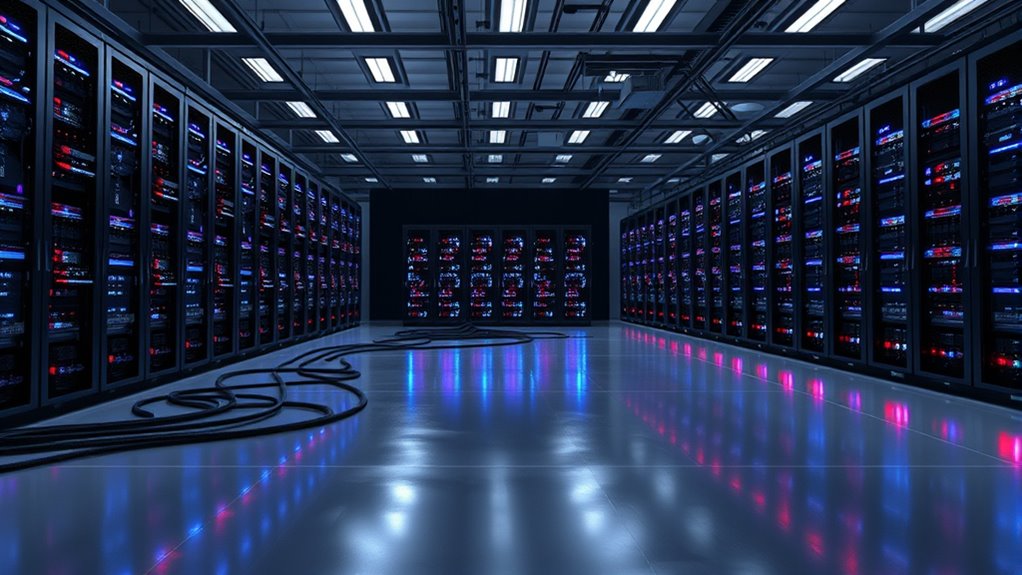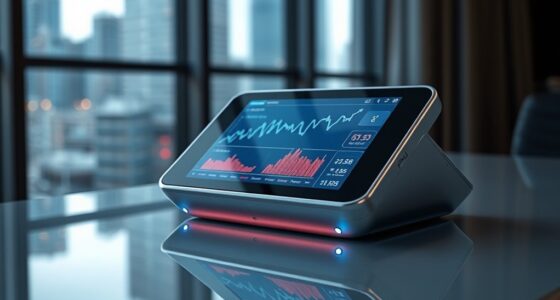As digital demands grow, your data center faces increasing energy needs that can overwhelm existing power supplies. This surge not only risks operational stability but also highlights the critical importance of renewable energy sources and innovative cooling technologies. Integrating solar, wind, and advanced cooling methods helps you cut reliance on fossil fuels, stabilize costs, and boost resilience. Staying ahead involves understanding these solutions; continue exploring to see how you can address the power crunch effectively.
Key Takeaways
- Rising data center energy demands strain existing power supplies, requiring innovative solutions to ensure reliable operations.
- Integrating renewable energy sources reduces reliance on fossil fuels and helps stabilize power costs.
- Advanced cooling technologies decrease energy consumption, improving efficiency and sustainability.
- Combining renewables with efficient cooling enhances data center resilience and future-proofing against power constraints.
- Regulatory trends favor greener practices, making energy management critical for operational stability and environmental responsibility.

As data centers become increasingly essential to our digital infrastructure, their power demands continue to surge, often outstripping available resources. This rapid growth puts immense pressure on existing energy supplies, prompting operators to seek innovative solutions. One key approach is renewable integration, where renewables like solar and wind are incorporated directly into the data center’s energy mix. By harnessing clean energy sources, you can reduce reliance on fossil fuels and lower your carbon footprint, all while helping to stabilize power costs over time. Renewable integration isn’t just environmentally responsible; it’s a strategic move to ensure a more resilient and sustainable energy supply for your operations.
Renewable integration enhances data center resilience and sustainability through clean energy and strategic resource management.
Alongside renewable integration, cooling innovations are transforming how data centers manage heat, which is a significant factor in energy consumption. Traditional cooling systems consume vast amounts of electricity, often accounting for nearly 40% of a data center’s total energy use. To combat this, you can adopt advanced cooling technologies such as liquid cooling, free-air cooling, or immersion cooling systems. These innovations improve efficiency by reducing energy waste and enabling your data center to operate at higher densities without overheating. For instance, liquid cooling directly removes heat from servers more effectively than conventional air cooling, cutting down on energy use and cooling costs. Similarly, free-air cooling leverages outdoor air to cool equipment during cooler months, drastically decreasing the need for mechanical cooling. Additionally, implementing energy-efficient cooling practices further enhances overall sustainability and reduces operational costs.
Implementing these cooling innovations isn’t just about cutting costs; it’s about future-proofing your data center. As power constraints tighten, the ability to efficiently manage heat becomes a critical advantage. Combining renewable energy sources with smarter cooling strategies allows you to create a more sustainable, energy-efficient environment. This synergy not only reduces your environmental impact but also enhances operational stability, helping you avoid costly outages or downtime caused by thermal issues.
Furthermore, integrating renewable energy and cooling innovations often involves technological upgrades and infrastructure investments, but the long-term savings and benefits outweigh these initial costs. You become less vulnerable to fluctuating energy prices and supply disruptions, ensuring your data center remains functional and efficient even under power constraints. As the demand for digital services grows, so does the importance of adopting these innovations. They enable you to align with regulatory trends favoring greener operations and demonstrate your commitment to sustainability.
Frequently Asked Questions
How Can Data Centers Reduce Their Energy Consumption Effectively?
You can reduce your data center’s energy consumption by optimizing cooling efficiency and integrating renewable energy sources. Implement advanced cooling systems like liquid cooling or free-air cooling to lower energy use. Additionally, incorporate renewable energy such as solar or wind power to decrease reliance on grid electricity. Regularly monitor and adjust energy management practices to identify inefficiencies, ensuring your data center operates sustainably and cost-effectively.
What Are the Latest Innovations in Sustainable Data Center Power Solutions?
You’re saving the planet one server at a time, right? Well, the latest innovations include smarter renewable integration and advanced thermal management systems. These upgrades cut energy waste, boost efficiency, and make sustainability look effortless—because who doesn’t want their data center to be both green and cool? Embracing these tech leaps means you’re not just keeping up; you’re leading the charge toward a cleaner, more efficient digital future.
How Does Energy Efficiency Impact Data Center Operational Costs?
You can substantially cut operational costs by improving energy efficiency in your data center. Using renewable energy sources reduces your carbon footprint and lowers energy expenses over time. Efficient cooling systems and smart power management help optimize energy use, saving money and supporting sustainability goals. By prioritizing energy efficiency, you not only reduce costs but also contribute to a greener future, making your data center more resilient and environmentally responsible.
What Policies Are Governments Implementing to Address Data Center Energy Use?
Governments are guiding green growth by implementing policies like renewable incentives and regulatory standards. They’re encouraging data centers to adopt sustainable solutions, reducing energy use and environmental impact. These policies promote renewable energy projects and enforce efficiency standards, making operations more eco-friendly. By backing innovative initiatives and establishing stricter regulations, governments help data centers cut costs, curb emissions, and contribute to a cleaner, greener future.
How Can Data Centers Prepare for Future Energy Supply Challenges?
To prepare for future energy supply challenges, you should prioritize renewable integration and enhance grid resilience. Invest in renewable energy sources like solar or wind to reduce reliance on fossil fuels. Collaborate with utility providers to improve grid stability and implement energy storage solutions. These steps help guarantee your data center remains operational during supply disruptions, ultimately supporting sustainability goals and maintaining reliable performance despite evolving energy challenges.
Conclusion
As you can see, the data center power crunch isn’t just a passing storm; it’s a wake-up call. If we don’t act now, we risk hitting a wall that could stall innovation and growth. Remember, every drop of energy counts, and ignoring this issue is like putting all your eggs in one basket. Stay informed and push for smarter solutions—because when it comes to powering our future, we can’t afford to be blindsided.








